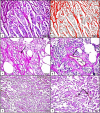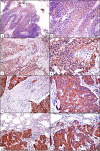N-myc downstream-regulated gene 1 can promote vasculogenic mimicry and angiogenesis in urothelial carcinoma
- PMID: 38561462
- PMCID: PMC11106159
- DOI: 10.1007/s00428-024-03793-w
N-myc downstream-regulated gene 1 can promote vasculogenic mimicry and angiogenesis in urothelial carcinoma
Abstract
Urothelial carcinoma (UC) of the bladder is a common cause of cancer-related death worldwide. Vasculogenic mimicry (VM) is a process by which the malignant cells can generate vascular-like structures formed of periodic acid-Schiff (PAS) positive/CD31 negative extracellular matrix independent of angiogenesis and thus promotes tumor progression. N-myc downstream-regulated gene 1 (NDRG1) is a protein that can modulate tumor angiogenesis; however, its role in regulating tumor angiogenesis and VM formation has not been previously investigated in UC. This study aims to evaluate the role of intra-tumor microvessel density (MVD) (as a surrogate measure of angiogenesis), VM, and NDRG1 in UC and their correlation with different clinicopathologic features, then assess the correlation between them in UC. Sixty specimens of UC of the bladder were included. PAS-CD31 immunohistochemical double staining method was used to evaluate the intra-tumor MVD and VM. Immunohistochemical expression of NDRG1 was also examined. VM and NDRG1 expression were detected in 41.7% and 83.3% of UC specimens respectively. The mean of intra-tumor MVD, VM area, and NDRG1 was significantly higher in tumors with higher grade, lymphovascular invasion, and higher T stage. NDRG1 expression was positively correlated with MVD and VM. We can suggest that MVD, VM, and NDRG1 may serve as poor prognostic markers for UC. The positive correlation between NDRG1 and both MVD and VM may provide the first evidence that NDRG1 can induce tumor angiogenesis and VM in UC which may offer a novel pathway for further therapeutic strategies.
Keywords: MVD; NDRG1; Urothelial carcinoma; Vasculogenic mimicry.
© 2024. The Author(s).
Conflict of interest statement
The authors have declared no conflict of interest.
Figures



Similar articles
-
Clinical significances and prognostic value of cancer stem-like cells markers and vasculogenic mimicry in renal cell carcinoma.J Surg Oncol. 2013 Nov;108(6):414-9. doi: 10.1002/jso.23402. Epub 2013 Aug 29. J Surg Oncol. 2013. PMID: 23996537
-
Expression of pigment epithelium-derived factor and tumor necrosis factor-α is correlated in bladder tumor and is related to tumor angiogenesis.Urol Oncol. 2013 Feb;31(2):241-6. doi: 10.1016/j.urolonc.2010.12.001. Epub 2011 Feb 2. Urol Oncol. 2013. PMID: 21292512
-
CD105-microvessel density analysis and its clinical value in urothelial carcinoma of bladder patients.Biomarkers. 2025 Feb;30(1):23-36. doi: 10.1080/1354750X.2024.2435876. Epub 2024 Dec 13. Biomarkers. 2025. PMID: 39668728
-
Increased NDRG1 expression is associated with advanced T stages and poor vascularization in non-small cell lung cancer.Pathol Oncol Res. 2012 Jul;18(3):549-56. doi: 10.1007/s12253-010-9294-2. Epub 2010 Sep 18. Pathol Oncol Res. 2012. PMID: 20853080
-
POU2F3-positive small cell carcinoma of the bladder: A clinicopathologic analysis of 4 cases and literature review.Pathol Res Pract. 2024 May;257:155296. doi: 10.1016/j.prp.2024.155296. Epub 2024 Apr 11. Pathol Res Pract. 2024. PMID: 38615507 Review.
References
-
- Kaseb H, Aeddula NR (2022) Bladder cancer. In: StatPearls [Internet]. StatPearls Publishing, Treasure Island FL Available from: https://www.ncbi.nlm.nih.gov/books/NBK536923/
-
- Huang C, Li Y, Ling Q, Wei C, Fang B, Mao X, Yang R, Zhang L, Huang S, Cheng J, Liao N, Wang F, Mo L, Mo Z, Li L. Establishment of a risk score model for bladder urothelial carcinoma based on energy metabolism-related genes and their relationships with immune infiltration. FEBS Open Bio. 2023;13:736–750. doi: 10.1002/2211-5463.13580. - DOI - PMC - PubMed
MeSH terms
Substances
LinkOut - more resources
Full Text Sources
Medical

